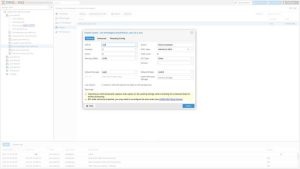Availability of Proxmox Virtual Environment 8.3 Virtualization Platform
With support for Ceph Squid, faster container backups, migration from other hypervisorsMigration from other hypervisors, alignment of Software-Defined Networking stack with firewall, Webhook target for notification system, and Tag View functionality for resource tree
This is a Press Release edited by StorageNewsletter.com on November 28, 2024 at 3:50 pmProxmox Server Solutions GmbH has released version 8.3 of its virtualization platform Virtual Environment.
VE 8.3 screenshot: OVA import
Click to enlarge
The enterprise virtualization solution features essential management tools and a user-friendly web interface, allowing organizations of all sizes, sectors and industries, to deploy open-source solutions in clustered, highly available setups. The WW customer base uses it to deploy extensive infrastructures across vast geographical locations, and integrate multiple applications.
This version is based on Debian 12.8 (Bookworm), but uses the Linux kernel 6.8.12-4 as stable default, and allows for opt-in use of kernel 6.11. The software includes updates to the latest versions of leading open-source technologies for virtual environments like QEMU 9.0.2, LXC 6.0.0 , and ZFS 2.2.6 (with compatibility patches for Kernel 6.11).
Enhancements in Virtual Environment 8.3
-
Alignment of the Software-Defined Networking (SDN) stack with the firewall: The SDN technology allows users to create virtual zones and networks (VNets), enabling them to effectively manage and control complex networking configurations and multitenancy setups via the web interface of Proxmox VE. The SDN stack is now more closely integrated with the firewall, with the ability to automatically generate IP sets for VNets and virtual guests managed by the IP address management plugin. Referencing IP sets in the firewall rules simplifies their creation and maintenance. In addition, the opt-in firewall based on nftables now has the capability to filter forwarded network traffic at the host and at the virtual network (VNet) level. For example, this can be used to restrict SNAT traffic or traffic flowing from one Simple Zone to another.
-
Webhook target for the notification system: The flexible notification system in Proxmox solutions uses a matcher-based approach to route notifications to various target types, allowing for granular control over when, where, and how notifications are sent. The new webhook notification target enables users to trigger HTTP requests for events like system updates, cluster node issues, or backup job. It supports customizable request headers and body content, allowing for integration with any webhook-compatible service.
-
A new ‘Tag View’ functionality for the resource tree offers users a rapid and customizable overview of the virtual guests: The new ‘Tag View’ allows users to view their virtual guests grouped according to the assigned tags.
-
Support for Ceph Squid (technology preview): Virtual Environment 8.3 adds support for Ceph Squid 19.2.0 and continues to support Ceph Reef 18.2.4 and Ceph Quincy 17.2.7. The preferred Ceph version can be selected during the installation process.
-
Faster container backups: When backing up containers to Proxmox Backup Server, it is now possible to efficiently detect files that have not changed since the last backup snapshot. When possible, unchanged files are not processed, which can make container backups complete faster.
-
Migration from other hypervisors: The Proxmox developers have streamlined the guest import from files in Open Virtualization Format (OVF) and Open Virtualization Appliances (OVA). Proxmox VE now allows users to import OVF and OVA files directly from file-based storage via the web interface. This simplifies the guest import process and allows users to either upload OVA files from a local machine or download them from a URL. Additionally, Proxmox VE also offers an import wizard facilitating the migration of VMs from other hypervisors, such as VMware guests.
“Our virtualization platform is designed to empower enterprises with unparalleled efficiency and control,” said Thomas Lamprecht, CTO, Proxmox. “By integrating advanced SDN capabilities, we’re enabling businesses to simplify their IT infrastructure, improve agility, and drive scalable growth. We are currently developing the inaugural version of the Proxmox Datacenter Manager, which will provide a unified management interface for multi-datacenter operations and facilitate the effective management of multiple clusters across diverse data centers.”
“The open-source project Proxmox VE has experienced significant growth over the past few months, adding 300,000 active hosts, bringing the total to around 1.3 million. In the current dynamic business environment, we are well-positioned for growth, particularly as recent pricing shifts in the market create new opportunities for us to serve our customers more effectively,” said Tim Marx, COO, Proxmox. “Our commitment to quality and value has resonated strongly, and we’re excited to continue building on this momentum.”
Virtual Environment 8.3 is available for download at the company’s website. The ISO contains the complete feature-set and can be installed on bare-metal. Distribution upgrades from older versions of Proxmox VE are possible with apt. It is also possible to install VE 8.3 on top of Debian.
License: Virtual Environment is free and open-source software, published under the GNU Affero General Public License, v3.
Support subscriptions: For enterprise users, Proxmox Server Solutions offers a subscription-based support model, which provides access to the extensively tested Enterprise Repository, with regular updates via the web interface, as well as technical support on a subscription basis. Prices start at €110/year and CPU socket.
Resources:
Release Notes Proxmox_VE_8.3
Video: What’s new in Proxmox VE 8.3
Forum announcement















 Subscribe to our free daily newsletter
Subscribe to our free daily newsletter

